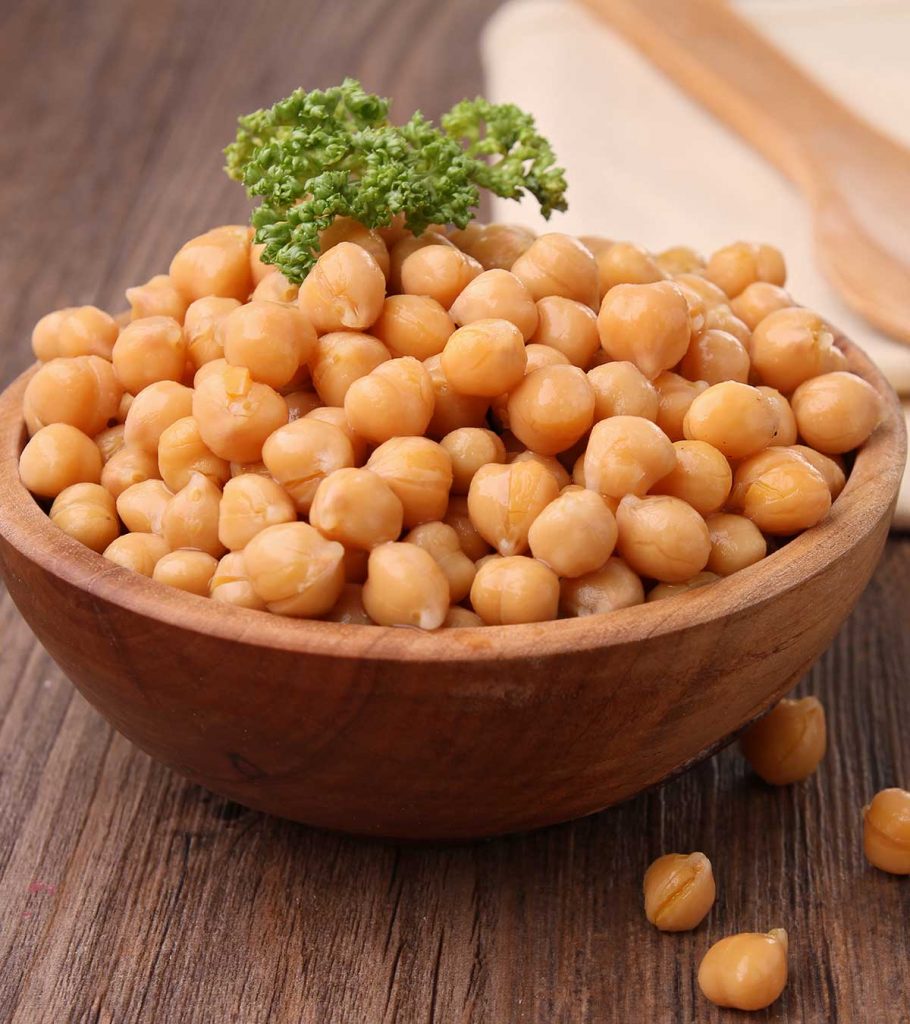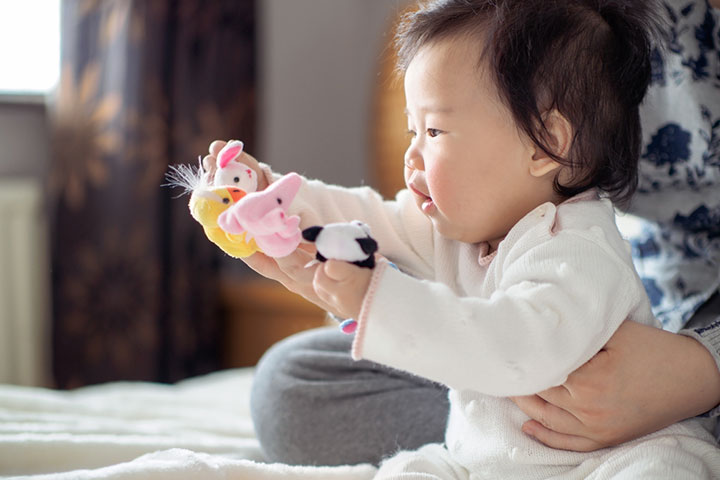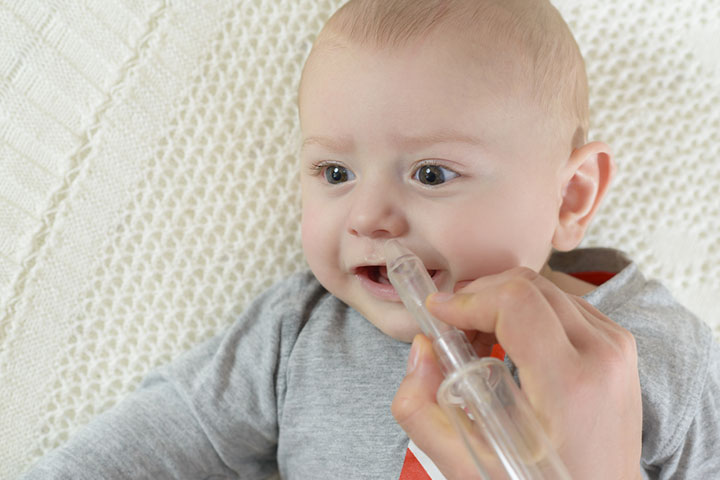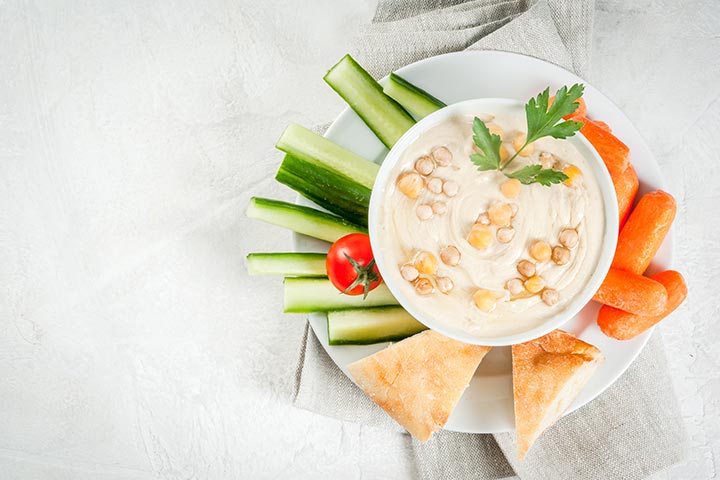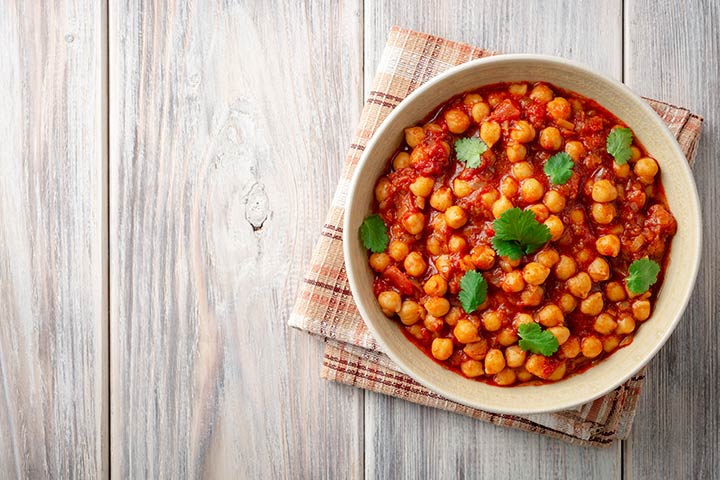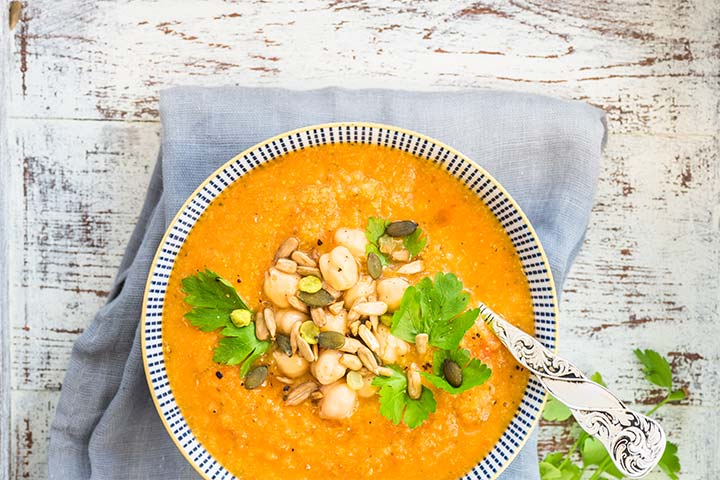Chickpeas are legumes that are also known as garbanzo beans, Kabuli chana, Bengal gram, and Egyptian pea. Chickpeas for babies can make for a good snack option or a wholesome meal. When cooked, these legumes have a huge fanbase due to the nutty flavor and grainy texture. In addition, they are good for health due to the several essential nutrients and bioactive compounds that they possess (1) (2). Read this post to learn more about the safety, benefits, nutritional value, possible side effects, and some delicious chickpea recipes for infants.
Are Chickpeas Safe For Babies?
Yes. Chickpeas can be considered safe for babies. The U.S Food and Drug Administration has categorized chickpeas as “Generally Recognized As Safe” (GRAS) for consumption (3). Many pediatricians recommend adding chickpeas to the baby’s balanced diet once the baby starts solids.
When Can Babies Start Eating Chickpeas?
Pediatric nutrition experts recommend feeding legumes to babies once they attain the age of six months (4). Depending upon the signs of readiness, infants can start solids anytime between four to six months. However, as each baby is unique, it is best to consult a pediatrician before you start feeding chickpeas to your baby.
Nutritional Value Of Chickpeas
Chickpeas are considered an excellent source of protein in a vegetarian diet. Besides, it has considerable amounts of minerals and vitamins that are essential for life. However, the most striking constituent of chickpeas is nutritionally important unsaturated fatty acids like linoleic and oleic acidiXA naturally occurring fatty acid found in plant-based foods (seeds and oils) known for cholesterol-reducing properties that are essential for the proper growth and development of the baby (1).
Below is the nutritional value of one cup of chickpeas with the recommended dietary allowance of nutrients for babies.
| Name | Amount | RDA (per day) |
|---|---|---|
| Water | 98.2g | – |
| Energy | 267Kcal | – |
| Protein | 14.4g | – |
| Total lipid (fat) | 4.22g | – |
| Carbohydrate, by difference | 44.7g | – |
| Fiber, total dietary | 12.5g | – |
| Calcium, Ca | 80.4mg | 270mg (7-12 months) |
| Iron, Fe | 4.71mg | 8.5mg |
| Magnesium, Mg | 78.7mg | 75mg (7-12 months) |
| Phosphorus, P | 274mg | 275mg (7-12 months) |
| Potassium, K | 474mg | 700mg (7-12 months) |
| Sodium, Na | 397mg | 200mg (7-12 months) |
| Zinc, Zn | 2.49mg | 5.6mg |
| Selenium, Se | 6.07µg | 12µg |
| Folate, total | 280µg | 32µg (7-12 months) |
| Choline, total | 69.7mg | – |
| Carotene, beta | 26.2µg | – |
| Vitamin K (phylloquinone) | 6.56µg | 10µg |
Sources: U.S. Department of Agriculture (5) and World Health Organization (6)
Chickpeas have a considerable amount of several nutrients. Therefore, it is likely that its consumption, in the long run, would prove beneficial.
Health Benefits Of Chickpeas For Babies
A research study showed that chickpeas could be used to prepare an infant weaning food with minimal mineral and vitamin fortification (7). It suggests that chickpeas have adequate nutritional value, which could provide several health benefits to babies.
Below are some potential health benefits of chickpeas for infants.
- Proper growth and development: Chickpeas have good quality protein that could help in the growth and development of the baby. Protein is an essential nutrient to perform various physiological functions, including muscle development and enzyme formation (8).
- Promote brain development: Chickpeas are a good source of essential fatty acids like linoleic and oleic acid. These fatty acids are important to promote brain development, improve cognitive functions, and increase the body’s repairing ability (9). These processes are essential for babies, especially during the early years of life.
- Helps in anemia prevention: Babies are prone to anemia during the first year of life (10). According to World Health Organization (WHO) statistics, anemia affects approximately 40% of children aged six months to five years globally. Therefore, regular consumption of iron-rich foods is a must. One cup of chickpeas can provide almost 50 percent of the daily requirement of iron. However, the iron bio-availability from chickpeas is low (11).
- Supports bone and teeth development: Calcium is one of the essential minerals that support bone and teeth development in babies. Chickpeas are considered to be a good source of calcium that could potentially contribute to the daily requirement of calcium.
- Helps maintain gut health: A research study showed that chickpeas provide 60-75 percent of the daily requirement of prebioticiXCompounds that improve overall health by acting as food for the good bacteria present in the human gut carbohydrates in a single serving (12). Maintenance of gut health is important in babies, especially during the early years of life, to maintain good health in the long run (13).
- Ensures regular bowel movement: Besides maintaining gut health, dietary fiber from chickpeas also helps maintain regular bowel movement (14). This is an important benefit of eating chickpeas amongst babies as infant constipation is common, especially in babies on bottle feed.
- Physiological functions: Chickpeas have a good amount of folate. Folate is necessary to carry out various physiological functions like cell and tissue growth, development of RBC, and development of new protein (14).
- Supports immunity: Chickpeas are a decent source of zinc. It provides almost 50 percent of the daily zinc requirement. Zinc plays a central role in the immune system. It is important for the normal development and function of immune cells like neutrophils and natural killer cells (15).
- Prevention against many diseases: A research study showed that compounds like phytic acidiXA plant-based substance and antioxidant which stores phosphorus, sterolsiXSubstances similar to cholesterol, found in nearly all living organisms that are essential for cell growth and function, with bioactive compounds like carotenoidsiXColored pigments found in plant-based foods that act as a precursor in the vitamin A production and isoflavoneiXCompounds derived from plants known to possess antioxidant and anti-inflammatory properties found in chickpeas have the capability of lowering the clinical complications associated with various human diseases (16).
Chickpeas are nutritious and possess promising health benefits. However, it should not be considered a stand-alone superfood. It is best to include chickpeas as part of a balanced diet for the baby.
Side-Effects Of Chickpeas For Babies
Chickpeas have many health benefits to complement. However, it certainly has some side-effects that too warrant attention.
- Flatulence: Chickpeas contains oligosaccharidesiXA class of carbohydrates found in various foods, including legumes, known for their prebiotic qualities such as raffinoseiXA type of carbohydrate found in foods such as legumes and grains and stachyoseiXA complex carbohydrate found in certain beans and legumes, known to enhance gut health and immunity in humans. Humans cannot digest these due to the absence of an enzyme, alpha-galactosidase. These undigested oligosaccharides pass to the large intestine undigested, leading to the development of gas (17). Thus, excessive consumption of chickpeas in infants should be avoided.
- Anti-nutritional compounds: Chickpeas contain certain anti-nutritional compounds, such as tannic acid. These compounds are known to impair the absorption of certain nutrients in the body (18). Excess consumption of chickpeas might cause the baby to receive too many of these compounds, thus making the baby vulnerable to nutritional deficiencies.
- Allergy: Chickpea allergy is less common than soy or peanut allergy. However, it is highly possible. Chickpeas trigger an IgE-mediated hypersensitivity reaction that can be caused by eating or, in some cases, touching chickpea (19). A cross-reactivity is likely to happen if allergy to other legumes or lentils exists (20). The symptoms of chickpea allergy could range from rhinitis to anaphylaxis. Thus, practice caution while you plan to introduce chickpeas in your baby’s diet.
How To Select And Store Chickpeas?
Proper selection and storage of chickpeas play a crucial role in ascertaining their nutritional quality.
- Chickpeas are available in fresh and canned forms. While you select either, check for the quality standards. Buy organic chickpeas, processed and handled by trusted sellers.
- Dried chickpeas should be used within a year of buying. If stored for long, they tend to become drier, which increases cooking time.
- For canned chickpeas, buy cans that are not damaged, leaking, cracked, or have bulging lids or corners.
- After buying, store canned chickpeas in a cool, dry place. You could consider rinsing canned chickpeas with water before use, in order to lower the sodium content.
- Leftover chickpeas can be stored in the refrigerator for not more than two days.
Precautions To Take While Cooking Chickpeas
Cooking chickpeas properly can make it more palatable and nutritious for a baby.
- Legumes like chickpeas are known to cause flatulence. It is the reason that many parents deter from feeding legumes to babies. However, it can be easily managed by soaking chickpeas overnight before cooking. Another method that could help is germination. If you do not have a whole night, then soak chickpeas five to six hours before cooking.
- Chickpeas have anti-nutritional compounds that need to be reduced or removed. It can ensure the optimum bioavailability of nutrients. Thus, soaking and germination can come to rescue. However, as per some research studies, roasting is more helpful (21).
- Chickpeas have a hard skin, and sometimes softening agents such as baking soda is used to break the skin. This method is useful but exposes your baby to high sodium, which is not good for the baby’s kidneys.
- On soaking, chickpeas absorb water and tend to increase in size. So measure the portion size accordingly.
- While cooking chickpeas, add acidic ingredients such as tomatoes and vinegar once the chickpea is tender. If added too early, then the acidity of these ingredients can slow down the cooking of chickpea.
- The ideal way to serve chickpeas to the baby for the first time is in puree form. Sometimes, chickpeas may not cook well and stay intact. Therefore, mash the chickpea first and then prepare a puree to prevent the formation of lumps.
- As babies have a sensitive digestive system, introduce chickpeas in tiny amounts in the beginning.
When mashed thoroughly, its soft and mashed texture makes it a perfect finger food option for babies and toddlers. Either fresh or canned, chickpeas can be used to prepare various interesting recipes. Below are some recipes that you might like to try.
Chickpea(Garbanzo) Recipes For Babies/Infants
When it comes to baby food, it’s crucial to offer a range of nutritious options to your little one, and incorporating pureed chickpeas can be an excellent choice as they can add valuable nutrients and flavor to your baby’s diet. Once your baby gets used to chickpea puree, you may consider preparing the following recipes.
1. Hummus with boiled vegetables
Hummus is a dip or spread made from cooked, mashed chickpeas. You can use hummus as a dip to feed boiled vegetables to your baby. This recipe is a perfect addition to your baby’s midday or evening snack.
You will need:
- 1 cup cooked chickpeas, rinsed and drained
- ¼ cup lemon juice
- 1 large garlic, roughly chopped
- ½ tsp sea salt, to taste
- ½ cup tahini
- ½ tsp ground cumin
- 1 tbsp extra-virgin olive oil
- ½ cup chopped fresh parsley
How to:
- To start, put lemon juice, garlic, and salt in a blender. Blend until you get a smooth paste. Once done, let the mixture rest for approximately ten minutes.
- Now, add the tahini to the mix and blend until the mixture is thick and creamy.
- While running the blender, drizzle in some water. Scrape down the food processor, and blend until the mixture is smooth and creamy.
- Now add the cumin along with the cooked and drained chickpeas to the blender and blend well. While blending, pour some drops of olive oil and keep blending until you get a soft and creamy paste.
- As the paste is ready, pour it into a serving bowl and garnish with finely chopped parsley. Serve it to your baby with boiled or cooked vegetables.
- You can keep the leftover hummus in the refrigerator, covered, for up to 1 week.
2. Tangy chickpea curry
Tomato puree is the base ingredient of the recipe. Apart from the nutritional benefits, tomato also provides a tangy flavor and a pleasant color to the curry. You can serve this to your baby with hot steamed brown rice or plain fried rice.
You will need:
- 2 cups of chickpeas, drained and rinsed
- 2 tomatoes, quartered
- 1 onion, finely chopped
- 2 tsp. cumin seeds
- 4 green cardamom pods
- 1 black cardamom pod
- 2 sticks of cinnamon
- 4 cloves
- 5-6 fat garlic cloves
- 4 tbsp vegetable oil
- 2–3 green chilies, whole but pierced
- 1 tsp turmeric
- 1 tbsp. ground coriander
- ¼–½ tsp chili powder
- Salt, to taste
- ½ tsp tamarind paste
- ½ cup fresh parsley, finely chopped
How to:
- Put ginger, garlic, tomatoes, and a little water in a blender and blend to a smooth paste. Once done, set the paste aside.
- Now, heat the oil in a large saucepan. Once the oil is warm, add cloves, cardamom pods, cinnamon, and half the cumin seeds. Cook everything until you smell a fine aroma.
- As the aroma releases, add green chilies and onion and cook until the onion turns brown.
- Add the tomato paste with the turmeric, ground coriander, chili powder, and salt to the pan and cook over a moderate to high heat until the oil comes out at the sides. Keep stirring often.
- Meanwhile, use the remaining cumin seeds to make roasted cumin powder. Keep it aside.
- Finally, add the chickpeas and water (as much thick or thin you want the gravy) in the saucepan and bring everything to boil. After five minutes, let the gravy simmer over medium heat for eight minutes. Stir in the tamarind paste. You can also add a few mashed chickpeas to thicken the gravy.
- You can season the curry with chopped parsley and serve.
3. Chickpea and vegetable thick soup
Soups are appetizing and filling. They make a perfect early dinner recipe that can be served to babies as well. Adding various seasonal vegetables to soup intensifies its nutritional value and provides umpteen health benefits.
You will need:
- 1 cup dried chickpeas, soaked overnight and drained
- 1 cup diced tomatoes
- 2 medium carrots, mashed
- ½ onion, finely sliced
- 1 clove
- 1 rosemary sprig
- 4-5 garlic cloves, chopped
- 2 bay leaves
- ¼ tsp black pepper
- 11/2 cup grated parmesan cheese
- 1 celery stalks, chopped
- 1 tsp lemon zest
- Extra virgin olive oil
- Black salt, to taste
How to:
- Take a large pot and put it on medium heat. Once the pot is warm, add clove and the onion in the pot.
- Then add chickpeas, rosemary sprig, garlic, bay leaves, olive oil, salt, and cheese to the pot. Add five cups of water and bring everything to boil.
- After five minutes, reduce heat to low, cover the pot and keep it on simmer for about an hour, or until chickpeas are tender.
- Add the tomatoes, carrots, and celery. Cover the pot partially and simmer until the vegetables are tender.
- While the soup simmers, mix some rosemary, parmesan, lemon zest, and pepper in a bowl and keep it aside.
- Once all the vegetables are cooked, blend everything in a blender. This is ideal for infants under ten months. Whereas, for older babies, you can leave the soup as it is with mashed vegetables.
- Pour the soup into bowls and season. Sprinkle the parmesan-rosemary mixture on top.
Besides these, there are many other recipes that you can try for your baby. For example, you can prepare delicious crispy falafels using ground chickpeas, or add mashed chickpeas to salads or puree them with veggies like sweet potato or carrot to make a nutrient-dense meal. Chickpea stews are another delectable option to relish this adaptable legume. Remember to select recipes that are rich in nutrition.
Chickpeas for babies can be a great source of protein, fiber, calcium, and iron. Its linoleic and oleic acids play an important role in their growth and development. You may add chickpeas to your children’s diet in the form of soups, dips, or curries. It will help maintain children’s gut, improve their immunity, and prevent anemia. However, consumption of excess chickpeas may result in flatulence or allergies. To address this issue, soak the chickpeas well before cooking and let them germinate. Make chickpeas a regular part of your children’s diet and reap their many benefits.
Key Pointers
- Babies can safely consume chickpeas starting at six months old.
- Chickpeas are a rich source of protein, fatty acids, and other essential nutrients that promote healthy growth in babies.
- Chickpeas aid in muscle development, support bone and teeth growth, promote brain development, prevent constipation, and lower the risk of anemia in babies.
- Chickpeas may cause gas or allergic reactions in babies.
- To serve chickpeas to babies, make mild-spiced hummus, soups, or curries with vegetables.
Dig into this delightful and nutritious chickpea soup recipe specially designed for infants aged 8 months and above. This easy and wholesome dish is perfect for a convenient and tasty meal, focusing on your baby’s health.
